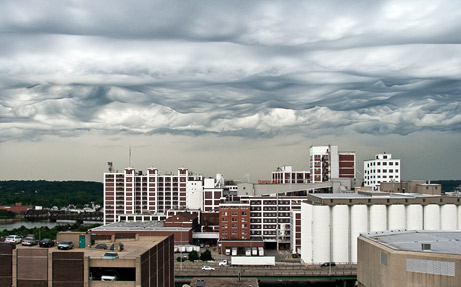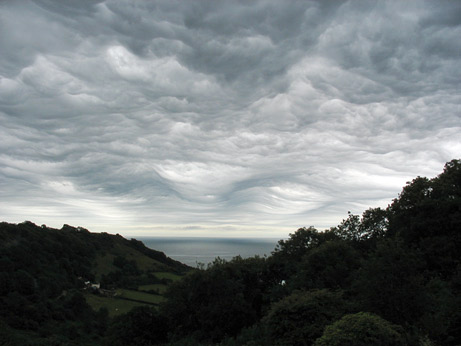Exotic clouds in the sky
Floating clouds in Cedar Rapids, Iowa State, in a dayless photo may be examples of a new kind of cloud discovered since 1951. Gavin Pretor Pinney - founder of the Assessment Association clouds also hope so.
Gavin, who is passionate about the beauty of the clouds in the UK, said he began taking strange and spectacular cloud pictures (including this photo) in 2005, but did not know how to define it.
A few months ago he began preparing to submit the strange patterns of clouds to the United Nations World Meteorological Organization to help classify clouds.
Pretor-Pinney jokingly called it the 'Jacques Cousteau cloud' because it looked like the ocean's stirred surface when viewed from below. But then he gave a more formal Latin name for it: Undulus asperatus , which could be interpreted as a kind of chaotic, powerful, and irregular ripple. He is also the author of the Handbook for Cloud Observers.

(Photo: Jane Wiggins)
Margaret LeMone - a cloud researcher at the National Center for Atmospheric Research in Boulder, Colorado, says she has taken a lot of intermittent asperatus cloud images over the past 30 years.
LeMone thinks it is likely that it will be a new kind of cloud. She also added: "Meteorology will get help if there is an enthusiastic collaborative research group for clouds."
When asked why such a strange cloud type was not recognized, Pretor-Pinney replied that the rarity of the cloud as well as the technology and the availability of cameras in hand were the answer. 'Technology has allowed us to get a new picture of the sky'.

(Photo: Richard Huntington)
This undated photo shows a cloud of asperatus hovering over New Zealand's southern island.
Whether this cloud is a new form is still a mystery. But experts suspect that the looming lower surface of the asperatus cloud may be due to strong winds that stir the previous cold and hot gas layers.
Asperatus clouds can boost the first new classification in the World Meteorological Organization's international cloud map since the 1950s, Gavin Pretor-Pinney said.
The last time added to the atlas, the appearance of satellite images motivated meteorologists to study to get a broader view of the weather and focus less on the picture. into small size clouds.

(Photo by Merrick Davies)
According to Pretor-Pinney, 'tides are returning', in part because normal small clouds are considered natural compasses for predicting climate change.
LeMone agrees that rattan is a large object that has not been transformed until climate change research, largely because climate change models do not provide sufficiently accurate measures to determine the impact of cloud with a changing world.
On the image is a supposed new form of cloud, asperatus, covering the sky of Perthshire, Scotland.
Gavin Pretor-Pinney - who proposed to officially recognize the asperatus cloud is a new type - saying it is being complained by people.
He said: 'People complain about having a cloud above their heads, while not thinking that they are admiring a beautiful view of life. For me, clouds are one of the most beautiful natural entities. '

(Photo: Ken Prior)
LeMone agrees with his views.'If you have a bad day, you can look outside and see a spectacular cloud,' she said.
If the asperatus cloud is recognized as a new form (in the picture asperatus clouds in Devon, England) it may be the first additional information for the World Meteorological Organization's cloud photo since 1951.
Supporter for Asperatus clouds - Gavin Pretor-Pinney and author of the Cloud Observer Hand - are always struggling to get people to have a better appreciation of the topic that interests him.
He said: 'Even if you live in the city center, the sky is the last natural space you can look at.'
- Watch the clouds with strange shapes
- Very strange, poisonous scales
- Clouds of strange shapes
- Terrifying foreboding of strange clouds
- Only watching flying clouds can predict the danger of weather
- French people stunned because of rotten clouds
- why do clouds have a lot of colors?
- Video: Giant scroll clouds across the Pacific Ocean
- Storm clouds contain both
- Explain the amazing characteristics of luminous clouds
- Clouds roll 1,000km across the sky
- Meteors can create glowing clouds
 Is the magnetic North Pole shift dangerous to humanity?
Is the magnetic North Pole shift dangerous to humanity? Washington legalizes the recycling of human bodies into fertilizer
Washington legalizes the recycling of human bodies into fertilizer Lightning stone - the mysterious guest
Lightning stone - the mysterious guest Stunned by the mysterious sunset, strange appearance
Stunned by the mysterious sunset, strange appearance